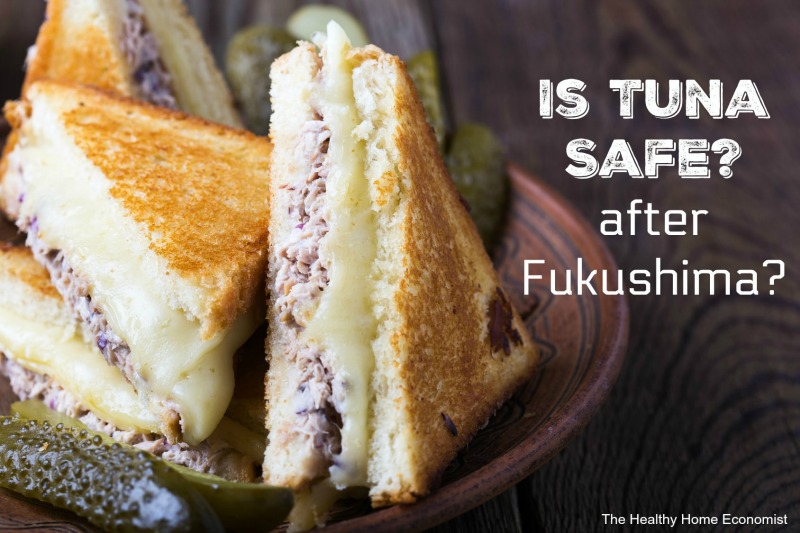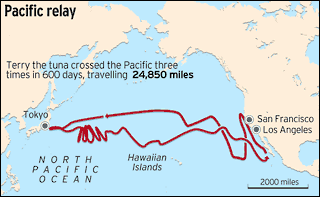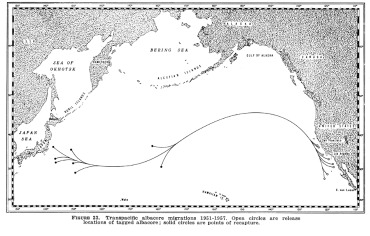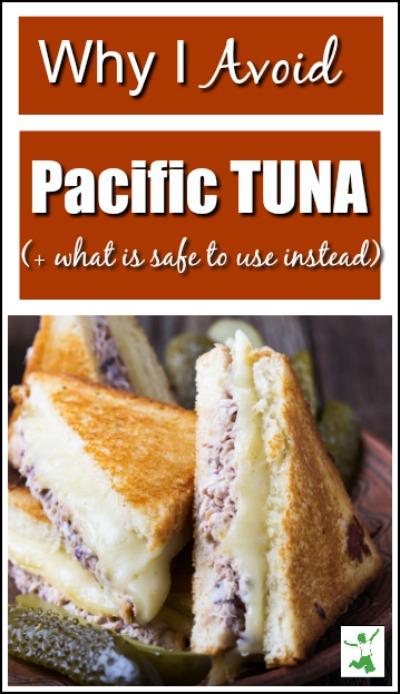
Tuna has always been a staple Real Food in our home. I’ve always taken care to source low mercury, sustainably caught tuna in order to prepare quality tuna steaks for dinner, tuna melts for lunch, or that old standby tuna salad for lunch boxes, quick snacks or just a dollop on a bed of greens. Spicy bluefin tuna rolls are a favorite of my husband when dining at Japanese restaurants.
About a year ago, however, I started to question my choice of tuna for regular consumption. I began reading the reports about the spreading radiation plume in the Pacific from the continuing Fukushima nuclear disaster. I delved into the migratory patterns of various species of tuna. The more I read, the more concerned, and quite frankly, confused I became.
Realizing that my family’s health can’t be wagered on guesses or half-truths, I gathered as much information as I could to arrive at an informed decision. Here’s what I found.
All species of tuna are highly migratory. This means that they swim long distances pretty much throughout their entire lives. These migration patterns are still ill-understood although it is generally agreed upon that they are large.

Pacific bluefin tuna are born near Japan spending their early months swimming in the radiation plume there. They then swim back and forth across the Pacific their entire lives. One tuna nicknamed Terry crossed the Pacific no less than 3 times in the span of only 20 months coming very close to Japan each time. To the right is a chart showing his epic swim.
The information gleaned from Terry the tuna is not new. As early as the 1950’s, tagged albacore tuna were known to swim thousands of miles as shown in this second chart to the right. The open circles off the California coast indicate where they were released and the solid circles closer to Japan indicates where they were recaptured.
 Highly migratory indeed!
Highly migratory indeed!
Atlantic based tuna exhibit the same nomadic patterns. According to National Geographic, high tech tags of Atlantic bluefin tuna revealed the following:
A team of international scientists documented two giant bluefins tagged within minutes of each other off the coast of Ireland. The two fish swam to opposite sides of the Atlantic Ocean–ending up more than 3,000 miles (5,000 kilometers) apart. One of the fish traveled 3,730 miles (6,000 kilometers) southwest to waters about 186 miles (300 kilometers) northeast of Cuba. The other remained in the eastern Atlantic and moved off the coasts of Portugal.
According to the Food and Agriculture Organization of the United Nation (FAO)s, all species of tuna, not just bluefin and albacore, are considered highly migratory, again with the reasons for these patterns not well understood. Here is a breakdown of the tuna species and where they are located according to a report by the FAO:
- Albacore tuna (Thunnus alalunga), which occurs in tropical and temperate waters worldwide.
- Bluefin tuna (Thunnus thynnus), mostly found in temperate waters of the Atlantic, including the Mediterranean, and Pacific Oceans. It is noted that since the adoption of UNCLOS, bluefin tuna in the northern Pacific has been identified as a different species, Pacific bluefin tuna (Thunnus orientalis) while bluefin in the Atlantic has been re-named Atlantic bluefin tuna.
- Bigeye tuna (Thunnus obesus), found in the Atlantic (but absent from the Mediterranean), Indian and Pacific Oceans.
- Skipjack tuna (Katsuwonus pelamis) with a worldwide distribution in tropical and temperate waters.
- Yellowfin tuna (Thunnus albacares), also with a worldwide distribution in tropical and sub-tropical more temperate seas, but absent from the Mediterranean.
- Blackfin tuna (Thunnus atlanticus) found in the western Atlantic in tropical and warm seas.
- Little tuna (Euthynnus alleteratus and E. affinis), with E. alleteratus found in tropical and subtropical waters of the Atlantic, including the Mediterranean, the Black Sea, the Caribbean Sea and the Gulf of Mexico, and E. affinis in the Indian and Pacific Oceans. It is noted that presently, E. alleteratus is called little tunny and E. affinis is called kawakawa.
- Southern bluefin tuna (Thunnus maccoyii), in temperate waters of the southern hemisphere in the Atlantic, Indian and Pacific Oceans.
- Frigate and bullet tuna (Auxis thazard and A. rochei) found in the Atlantic (including the Mediterranean Sea where only A. rochei is found), Indian and Pacific Oceans.
So Tuna Swim. A Lot. So What?
The fact that tuna swim great distances, constantly moving and migrating means that tuna in the Pacific more than likely will have passed through the growing Fukushima radiation plume at some point in their lives, probably numerous times.
With long-lived varieties like albacore (11-12 years) and bluefin (up to 20 years), this is especially true. With much smaller, shorter-lived tuna like the skipjack (about 8 years), less so.
Is the Fukushima Radiation Even Really a Problem?
The answer to this question depends on who you ask. Some reports say yes, the Pacific-based radiation plume from Fukushima is a serious problem and growing worse as 300 tons of radioactive water pours into the Pacific every single day with no end in sight for years. Unbelievably, Japan’s government only acknowledged the urgency of the situation in September 2013.
On the other hand, a comprehensive assessment by the World Health Organization (WHO) concluded that radioactive particles that are making their way to North American waters will have a limited effect on human health, with concentrations below WHO safety levels.
The most unsettling data to date is that the continued outflow of radioactive water from Fukushima now no longer just contains cesium isotopes. It now also contains the more worrisome strontium-90 which is a bone-seeking isotope.
Who is right? Who is wrong?
One thing is true, Fukushima is a nuclear disaster never before experienced in human history so all theories and probabilities are on the table.
Dr. Ken Buessler, a world expert in marine radioactivity with the Woods Hole Oceanographic Institution in Massachusetts who is leading an international research team tracking Fukushima’s trails in the Pacific has this to say:
We still don’t know the answers to many important questions concerning the impacts of Fukushima radionuclides on the oceans. For example, we still don’t have a good handle on how much radioactivity was released, and we don’t fully understand where it has ended up, and that holds for the ocean waters, seafloor sediments, and for marine biota, such as tuna.
Caution Seems to Be the Best Policy
Having personally known someone who died of radiation-induced cancer 15 years after the Chernobyl disaster from the fallout that blanketed parts of Europe which governments at the time said was no threat to human health (his wife lost most of her hair but has survived although they tragically had a daughter born a few years after the disaster who developed leukemia), I don’t take the long term, cumulative effects of radiation lightly and interpret official reports like the one published by the WHO with a grain of salt.
If you choose to interpret the data as a nonthreat to human health with the radiation levels within safe limits, that is, of course, your choice. My approach is both practical and cautionary to play it safe for my children’s sake until more information is gathered and the extent of the problem studied further. This includes avoiding all tuna from Pacific waters given that this particular migratory fish is prone to swimming close to Japan multiple times during its lifetime.
Since much of the time, the ocean of origin for tuna is unknown or not labeled, this would mean avoiding all tuna in most cases. This is exactly what I’ve been doing for the past six months or so – no tuna in my home. Period.
The complaining of my family about the absence of tuna dishes (which everyone loves) has caused me to continue to search for a source of tuna I would feel comfortable serving. I recently discovered a skipjack tuna from Portugal (source) that I’ve been purchasing for several years.
Buy Atlantic Based Tuna!
Given that Atlantic based tuna do not enter the Pacific during their lives, I felt at this time, this brand of sustainably-fished Atlantic tuna would be safe to eat.
However, predictions are for the Fukushima radiation plume to continue growing, eventually entering the Arctic and then the Atlantic Oceans, as the disaster is far from contained. As a result, this situation most likely will change in the coming years. For now, however, if tuna origin can be accurately confirmed, I will purchase and eat it – but only from the Atlantic Ocean and other non-Pacific sources.
What are your thoughts about eating tuna and other seafood? What data have you come across to support your decision? Do you continue to eat tuna? Why or why not?

References
(1) Radiation From Fukushima Could Help Solve the Mystery of Bluefin Tuna Migration
(2) Health risk assessment from the nuclear accident after the 2011 Great East Japan earthquake and tsunami, based on a preliminary dose estimation
(3) Tagged Tuna Reveal Migration Secrets
(4) Tuna’s 25,000 Mile Swim Down Marine Highway
(5) The Migration, Age, and Growth of Pacific Albacore (1951-1958)
(6) Should you Worry about Radiation in your Wild Pacific Fish?
(7) Highly Migratory Species of Fish
(8) Tuna Species








I’m dubious but in general, I agree to play it safe.
Ya kill the oceans ya kill everything. Fresh water comes from the oceans too. So goodbye cruel world. ROFL. ????
Thank you for the valuable information…
Just found out that WILD PLANET tuna tests every batch of tuna for radiation and mercury. A relative of mine called the company today and this is what they told her. They test more than once – and even one more time as they’re canning it. When she asked what levels of mercury and radiation their tuna has – she was told “zero” that their tests can detect. (Couldn’t believe it.) They also said that they use young North Atlantic tuna that are smaller from controlled waters to avoid the radiation. So … wanted to pass this on. I actually had tuna fish sandwiches tonight!
Wondering what brand of tuna you found from the Atlantic and where you purchase??
Thanks for your help!
Link to what I have vetted and by for my home is in the post. Here it is again. https://www.radiantlifecatalog.com/product/1520/seafood/?a=58537
Hi Sarah
I just read your – Is it safe to eat tuna post Fukushima – article, and I have a concern that isn’t being addressed, but first, thank you for sharing it with anyone who isn’t too busy or too disinterested to do this kind of reading.
How reassuring that WHO says the levels of Caesium in tuna are below what is considered unsafe for human consumption, ingestion or exposure, NOT.
The reason I say this is that such statements are made in isolation. If we all lived in a pristine world, untouched and uncontaminated by humans, we could probably safely say this. Unfortunately we have to take into consideration many other factors, and there is currently no way to assess their cumulative effect, which is what our immune systems, the kidneys, the liver and so on all have to contend with and deal with.
Take for example, the level of contaminants in city air in the presence of a plague of automobiles, or the herbicides and pesticides in our food supplies, all the chemicals added by manufacturers into processed foods, the contaminants and toxins in the water we drink, the release of fumes inside our homes from cleaning chemicals, the release of chemicals from manufactured materials in the home that are released continuously over time, the empty calories we eat that must be burned, eliminated or stored, and which in general cannot be burned, we are very many of us too sedentary, cannot be eliminated quickly enough, and are therefore to a considerable extent stored as fat in our bodies creating the perfect place to also store all sorts of contaminants and toxins.
It makes little sense for WHO to say eating Pacific caught tuna is safe, because they say this in isolation of all the other body burdens we have to deal with. We have finally admitted that people who do not smoke can die from cancer or emphysema due to smoking, because of the effects of second hand smoke, and this should alert us to the fact that if we want to eat Pacific caught tuna, we probably need to live in the countryside and only eat organic everything else, never eat processed food, be very careful about where the water we drink comes from, don’t spend much time in the city, and do on.
If we do all those things I listed, we probably have to consider that eating Pacific caught tuna in addition makes eating this tuna unsafe, but then so are all those other things, so it doesn’t really matter if this tuna is contaminated, in which case we should have already accepted the likelihood we will suffer from grave health consequences at some point, and will not lead a life untroubled by illness and disease, and then die quietly in our sleep at the age of say 95.
I’m afraid most of humanity is in denial about certain things and in general about a lot of things. We have a lot of faulty beliefs, and adverse values, we engage in moral and ethical rationalisations, and we are wilfully blind in most of these areas. These traditions are passed down in families, which is why wealthy people believe they are right in everything they do, are entitled to their lifestyles, and suspect that poor people have something wrong with them, and that the poor unreasonably envy and unjustly criticise the rich. In general the elite classes tend to mix only with their own kind, and they look around and see their friends, families and colleagues behaving as they do, which leads to confirmation bias, if everyone is like me, I must be normal, and I must be living as one would imagine and expect a good person to live.
I also blame a global failure of education that was designed to serve an era that ceased to be more than one or two centuries ago, but we have clung to that same old model of education, especially as this serves the needs of capitalism, which needs to exploit over a large part of their lifetimes, and would not be able to do so successfully if everyone was more completely and appropriately educated, which would seriously undermine and shorten the era of the ultra rich, and their corrupt government enablers.
We are essentially still the same old savages underneath, and it is probably only the false veneer of civilised society and our advanced technology that allows us to believe otherwise, nevertheless, we still a Type Zero Civilisation, as defined by Professor Michio Kaku, and we still quickly resort to war as our default choice for resolving issues of greed, entitlement, fear, disagreements, commercial interests, and a desire to exploit and control the world. It should not have escaped our attention, but it has, or we would be appalled at the prospect that some of our most advanced and complex science and technology is for the purpose of mutually assured self annihilation.
With regard to Fukushima, an event following Chernobyl, Chelyabinsk-40 and Chelyabinsk-65 explosion near Kyshtym, and Three Mile Island, not forgetting the poignant record of Hiroshima and Nagasaki, to mention most of the more significant commonly known nuclear accidents and acts of war, yet still we continue to build fission power plants, and dump radioactive waste into the environment in the form of Uranium case hardened ordnance that becomes pulverised radioactive contaminated dust inundating the streets of our cities and our homes, typically causing a 40 times elevation in local birth defects, cancers and leukaemia, and we have cumulatively 150 times the number of nuclear warheads required to wipe out the human species. We should not forget to mention that we have biological and chemical weapons too, and have used these with effect that still has consequences reflected in birth defects and cancers today in Asia, and in the US against Native Americans in time past, although the intent to cause harm during war through the use of infectious agents goes back 2500 years
Most of human activity, what we say and what we do, is harmful, is contraindicated, and the result of an unintelligent species, or an intelligent but genetically self destructive one, and the WHO statement serves only to illustrate what is a tendency for humans to engage in one dimensional thinking, and perhaps the most delusional nation on Earth, the USA is a perfect example of human paradox, a nation that believes in its godly correctness and goodness, which it sometimes is, but mostly is not, and the perfect example of this is its rhetoric with respect to Russia, including US accusations that Russia has global expansion intentions and yet the US has established its own version of a Maginot Line in perhaps 80 nations, placing all of them potentially on the US front line of any military conflict, and conflict has been the signature behaviour of the US, and even during the 200 years before the writing of the US Constitution.
If it isn’t Caesium contamination of the oceans it is plastic micro particles that we will eventually be likely to consume through eating fish.
In short, we have contaminated our water supply, our food, the land and the oceans, and even the air we are all forced to breathe, the one thing we cannot do much to avoid, unless we go and live in the Andes or live inside an air filtration device. Not even the rich can avoid that hazard unless they seal themselves hermetically inside their homes for life using only a airlock system to admit nutrition and eliminate waste materials. It has become almost irrelevant whether Pacific caught tuna is safe to eat or not safe to eat, as we escalate the things we are doing that place our survival at risk.
Nobody is yet talking about a plan for the worst case scenario where the human population had grown to 11 billion and Global Warming results in a migration of refugees numbering 2 billion or more, making the several millions from Syria, Iraq, Palestine, and sub-Saharan Africa look like a small problem, given that 88% of human beings are i the Northern hemisphere, and both Canada and the US along with Australia, and Europe, including Russia will need to absorb these 2 billion people, making it look lovely that Canada will need to make way for up to 450 million, the US 350 million, Australia 200 million, Europe 250 million and Russia perhaps 750 million.
Contaminated tuna will be a good option under these circumstances, and a life expectancy of 50 years may be one of the new realities following the 300 year long era of reckless capitalism, global naivety and inability to think and comprehend achieved through our global education system, and a flawed global human belief habit.
Perhaps the mantra of the future will be changed from – let them eat cake – to – let them eat tuna.
We discontinued ocean source foods consumption the week of the disaster. We purposely by mined salts vs. sea salts for home use too as a way to at least mitigate exposure. At this time we do not own the correct type of Geiger counter to assay and identify radioisotope content and types ranging through to Plutonium and others in our food but figuring that Fukushima continues to add to the volume of classified and unclassified military and industrial nuclear accidents along with waste, it does not make sense for us to risk consuming an unknown quantity of dangerous material from sea foods both plant and animal now that the ocean has truly become a filthy sewer!
PS:See also ‘Buckyballs of radiation Fukushima’ and fairewinds.org
I’m sure we all want to put this in perspective rather than just to spread alarmist panic. According to a graduate researcher from the Oregon State University Radiation Health Physics program, “To increase their normal annual dosage of radiation by just 1 percent, a person would have to eat more than 4,000 pounds of the highest (radiation) level albacore we’ve seen.” [See: research.engr.oregonstate.edu/radioecology/feature-story/pacific-albacore]
I like tuna a lot, but I think consuming two TONS of the stuff, even spread out over a single year would be more than a bit of a challenge.
While the OSU study was focused on Albacore tuna, their results are not that much different in conclusions from that published for the National Academy of Sciences which DID evaluate Pacific Bluefin Tuna (the subject of the OP video). Putting things in perspective, the PNAS paper observed “Consumption of 200 g (a typical restaurant-sized serving) of PBFT … resulted in committed effective doses of 3.7 and 4.0 nSv, respectively. To put this into perspective, the combined dose of 7.7 nSv from these two Cs isotopes is only about 5% of the dose acquired from eating one uncontaminated banana …” [See: pnas.org/content/110/26/10670.full.pdf] In other words, if you’re willing to eat bananas, tuna, whether Albacore or Pacific Bluefin should be OK too.
Hello Erik,
You said you will never eat fish again. Just to confirm, is all fish off the table for you, or just Tuna? And why? How does everyone else feel about general fish consumption? Or is Tuna the only target?
Thanks!
Thank you very much for your thorough research on tuna migration and high risk exposure to radioactive cesium and strontium! My wife and I do not eat canned tuna but our beautiful 11 years bichon loves it therefore I keep buying albacore tuna from Fiji processed in the US. Recently due to my awareness and medical knowledge I started interested in tuna species and radiation again, also because of our lovely dog’s aging health. I only purchase canned sardines from Portugal or Morocco in Traders Joe or other stores and frozen wild salmon from the North!